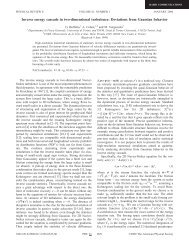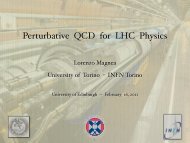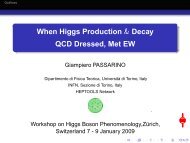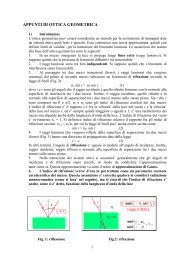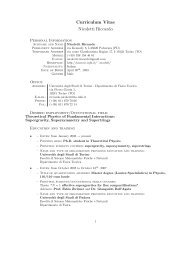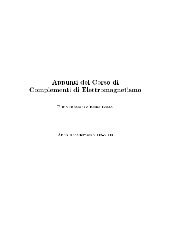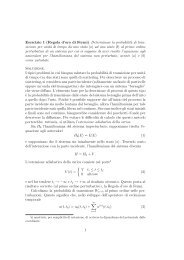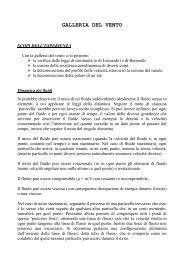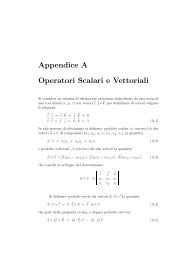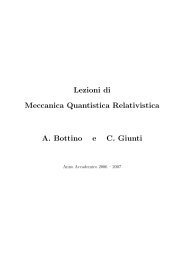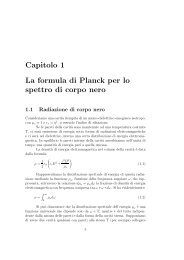Appunti di Meccanica Statistica - INFN
Appunti di Meccanica Statistica - INFN
Appunti di Meccanica Statistica - INFN
- No tags were found...
Create successful ePaper yourself
Turn your PDF publications into a flip-book with our unique Google optimized e-Paper software.
54 CHAPTER 2. GLI “ENSEMBLES” DI GIBBSOgniqualvolta qualche grandezza termo<strong>di</strong>namica ha una singolarità per undato valore <strong>di</strong> T si <strong>di</strong>ce che il sistema subisce in quel punto una transizione <strong>di</strong>fase. Dunque la condensazione <strong>di</strong> Bose- Einstein è una transizione <strong>di</strong> fase che simanifesta in un gas <strong>di</strong> Bose ideale a bassa temperatura. 12( Ve<strong>di</strong>amo ora altre proprietà termo<strong>di</strong>namiche del sistema a T < T c . Da C V =∂E)∂TVPoichè inoltreC V = T( ) ∂S, ⇒∂TV⇒ C V = 5 E2 T( ) ∂S∂TV= C VT = 5 E2T 2⇒ S =∫ To5 E 152 T 2dT=4( ) 3 ∫ 2mπ2 T √Vh 2 ζ5 (1)κ 5 2 TdT =2o= 154( )32mπ2Vh 2 ζ5 (1)κ 5 222Quin<strong>di</strong> l’energia libera F = E − TS è data daF = E − 5 3 E = −2 3 E3 T 3 52 =3e la pressione vale p = − ( )∂F= 2 E. Si ottiene, come c’era da aspettarsi, la∂V T 3 Vstessa relazione trovata per T > T c . Notiamo che ora si hap =ed è quin<strong>di</strong> in<strong>di</strong>pendente da V. 13( )32mπ2h 2 ζ5 (1)(κT) 5 2212 Questa transizione fu prevista da Einstein già nel 1926, ma e stata osservata sperimentalmentesolo <strong>di</strong> recente (1995) in gas rarefatti ( in particolare Na a bassissima pressione per realizzare il lecon<strong>di</strong>zioni <strong>di</strong> gas perfetto) a temperature dell’or<strong>di</strong>ne <strong>di</strong> 10 −6 Kelvin.13 Il fatto che nella fase fredda T ≤ T c le espressioni (e la derivazione) delle principali grandezzetermo<strong>di</strong>namiche siano particolarmente semplici è dovuto all’eliminazione del vincolo sulla conservazionedel numero <strong>di</strong> molecole, per cui il sistema è <strong>di</strong> fatto descritto dal formalismo canonico,in quanto entrano in gioco solo le molecole negli stati eccitati: una variazione <strong>di</strong> T provoca unaconseguente variazione <strong>di</strong> N exc , mentre vale z = 1 in tutta la regione.ET




